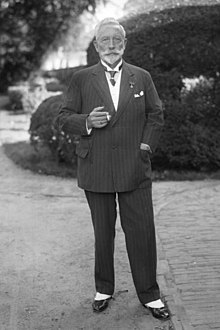This article may require copy editing for grammar, style, cohesion, tone, or spelling. (November 2023) |


Kaiser Wilhelm II was exiled to The Netherlands in 1918, he died in 1941 in exile, he had a child and his wife living with him whilst in exile. He died while the Nazis occupied the Netherlands. The Allies wanted to punish Wilhelm as a war criminal but the Queen of The Netherlands Wilhelmina refused to extradite him.[1] Wilhelm had a peaceful life in Doorn,The Netherlands in his home. The home now has a bust of the Kaiser and it is a museum now.[2]
Abdication of Wilhelm II edit
The abdication of Kaiser Wilhelm II was declared by Chancellor Maximilian of Baden on 9 November 1918 as a result of the German Revolution of 1918–19,the abdication caused the German Empire to dissolve and House of Hohenzollern's rule of Germany Wilhelm first settled at Amerongen Castle, where on 28 November he issued a belated statement of abdication of both the Prussian and imperial thrones.
| Text and/or other creative content from this version of Abdication of Wilhelm II was copied or moved into Draft:Wilhelm II exile to The Netherlands with this edit on 22:49, 3 November 202. The former page's history now serves to provide attribution for that content in the latter page, and it must not be deleted as long as the latter page exists. |
statement of Abdication. I herewith renounce for all time claims to the throne of Prussia and to the German Imperial throne connected therewith. At the same time I release all officials of the German Empire and of Prussia, as well as all officers, non-commissioned officers and men of the navy and of the Prussian army, as well as the troops of the federated states of Germany, from the oath of fidelity which they tendered to me as their Emperor, King and Commander-in-Chief. I expect of them that until the re-establishment of order in the German Empire they shall render assistance to those in actual power in Germany, in protecting the German people from the threatening dangers of anarchy, famine, and foreign rule. Proclaimed under our own hand and with the imperial seal attached. Amerongen, 28 November 1918. Signed WILLIAM[3].
Life in exile edit
In 1922, Wilhelm published the first volume of his memoir[4] a very slim volume that insisted he was not guilty of initiating the Great War, and defended his conduct throughout his reign, especially in matters of foreign policy.
Wilhelm lived in Doorn,The Netherlands[5]
Wealth edit
Wilhelm II was seen as the richest man in Germany before 1914. After his abdication he retained substantial wealth. It was reported that at least 60 railway wagons were needed to carry his furniture, art, porcelain and silver from Germany to the Netherlands. The kaiser retained substantial cash reserves as well as several palaces[6]
See also edit
References edit
- ^ Editors, History com. "Kaiser Wilhelm II". HISTORY. Retrieved 2023-01-22.
{{cite web}}:|last=has generic name (help) - ^ "House and collection". www.huisdoorn.nl (in Dutch). Retrieved 2023-04-27.
- ^ Statement of Abdication (1918). As translated and appearing in the 1923 Source Records of the Great War, Vol. VI, edited by Charles F. Horne
- ^ WILHELM II (1922). THE KAISER'S MEMOIRS. Universal Digital Library. HARPER & BROTHERS PUBLISHERS.
- ^ "Kaiser Wilhelm II - WWI, Abdication & Death". History.com. Retrieved 2023-04-27.
- ^ "His Ancestors Were German Kings. He Wants Their Treasures Back. - The New York Times | Ghostarchive". ghostarchive.org. Retrieved 2023-04-27.